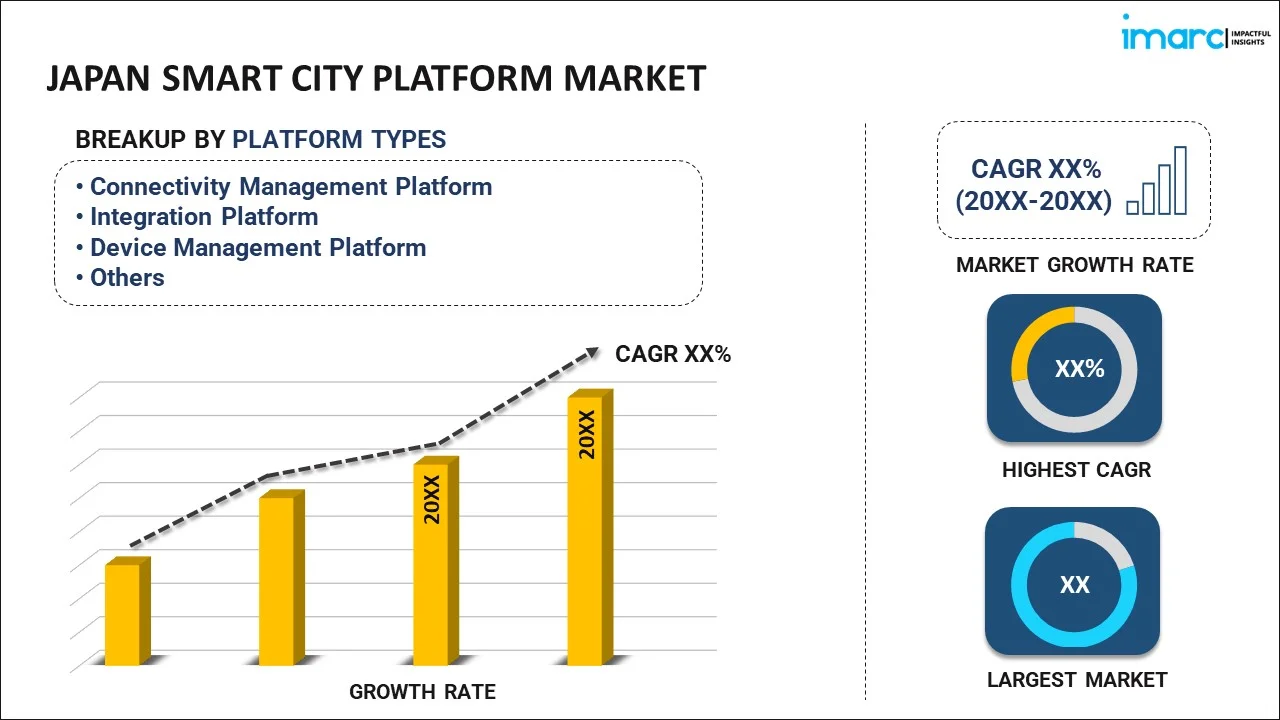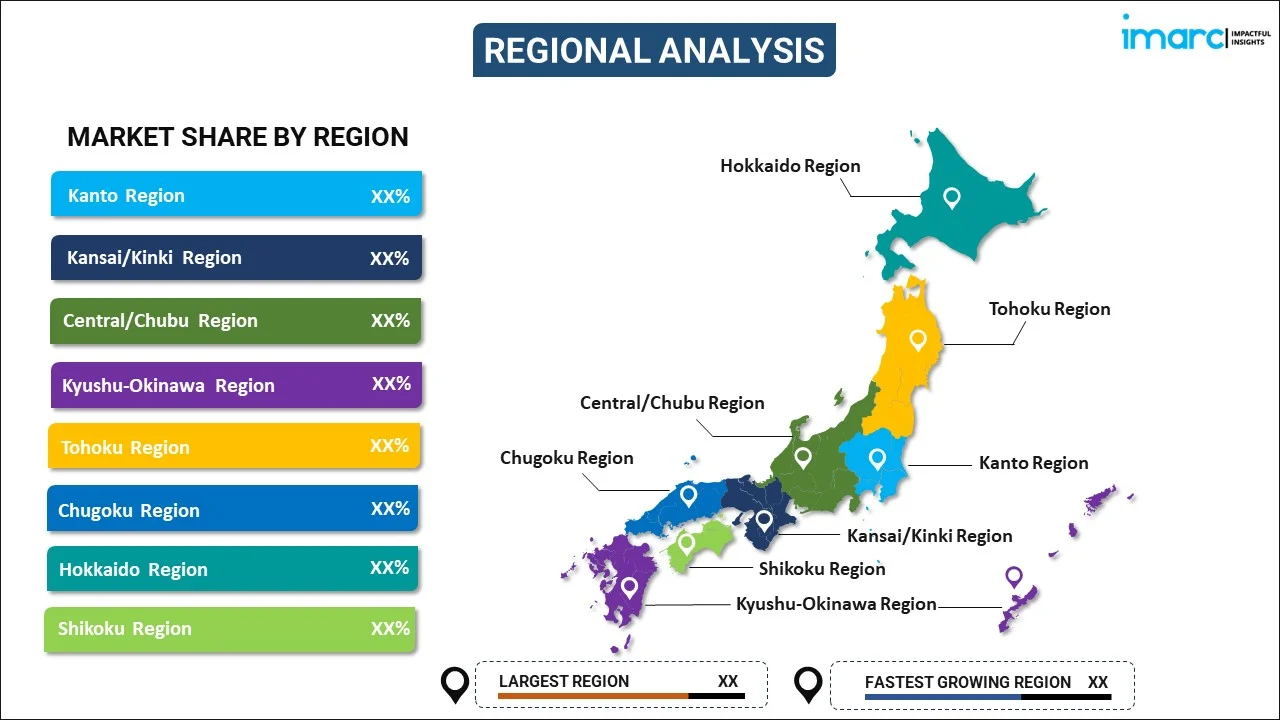
Japan Smart City Platform Market Report by Platform Type (Connectivity Management Platform, Integration Platform, Device Management Platform, Data Management Platform, Security Management Platform), Deployment Mode (On-premises, Cloud-based), Application (Smart Mobility/Transportation, Smart Security, Smart Utilities, Smart Governance, Smart Infrastructure, Smart Healthcare, and Others), and Region 2025-2033
Market Overview:
Japan smart city platform market size reached USD 2.4 Billion in 2024. Looking forward, IMARC Group expects the market to reach USD 4.8 Billion by 2033, exhibiting a growth rate (CAGR) of 11.7% during 2025-2033. The rapid advancement of technology, particularly in areas like Internet of Things (IoT), 5G connectivity, and data analytics, which has made it easier to collect and analyze data for smart city initiatives, is driving the market.
|
Report Attribute
|
Key Statistics
|
|---|---|
|
Base Year
|
2024
|
|
Forecast Years
|
2025-2033
|
|
Historical Years
|
2019-2024
|
|
Market Size in 2024
|
USD 2.4 Billion |
|
Market Forecast in 2033
|
USD 4.8 Billion |
| Market Growth Rate 2025-2033 | 11.7% |
A smart city platform is a technological framework that leverages digital infrastructure to enhance urban living, sustainability, and efficiency. It integrates various data sources, such as sensors, IoT devices, and databases, to gather real-time information about a city's operations and services. This data is then processed and analyzed to make informed decisions and optimize resource allocation. Smart city platforms enable improved urban planning, traffic management, and public safety. They also foster citizen engagement by offering applications and services accessible through mobile apps or web portals, allowing residents to report issues, access information, and participate in local governance. These platforms often incorporate technologies like artificial intelligence, machine learning, and big data analytics to predict and mitigate issues such as traffic congestion, air quality, and energy consumption. Ultimately, the goal of a smart city platform is to create more sustainable, livable, and connected urban environments by harnessing data and technology to enhance the quality of life for residents while minimizing resource waste and environmental impact.
Japan Smart City Platform Market Trends:
The smart city platform market in Japan is experiencing robust growth due to several interconnected factors. Firstly, the rapid urbanization observed regionally has created a pressing need for efficient city management solutions. As cities expand, the demand for streamlined services such as transportation, energy, and waste management increases, driving the adoption of smart city platforms. Moreover, the escalating concerns surrounding environmental sustainability have played a pivotal role in propelling this market forward. Smart city platforms enable cities to implement eco-friendly initiatives like energy-efficient lighting, reduced emissions, and optimized resource utilization. This alignment with sustainability goals has garnered substantial support from governments and regulatory bodies, further boosting market prospects. Additionally, the proliferation of IoT technology is a key driver. The interconnectedness of devices and sensors within a smart city ecosystem enhances data collection and analysis, leading to improved decision-making and resource allocation. This technological synergy is catalyzing market growth as it enables cities to optimize their infrastructure efficiently. Furthermore, the ongoing advancements in artificial intelligence and data analytics, which provide actionable insights for better urban planning and citizen services, are expected to drive the smart city platform market in Japan in the coming years.
Japan Smart City Platform Market Segmentation:
IMARC Group provides an analysis of the key trends in each segment of the market, along with forecasts at the country level for 2025-2033. Our report has categorized the market based on platform type, deployment mode, and application.
Platform Type Insights:

- Connectivity Management Platform
- Integration Platform
- Device Management Platform
- Data Management Platform
- Security Management Platform
The report has provided a detailed breakup and analysis of the market based on the platform type. This includes connectivity management platform, integration platform, device management platform, data management platform, and security management platform.
Deployment Mode Insights:
- On-premises
- Cloud-based
A detailed breakup and analysis of the market based on the deployment mode have also been provided in the report. This includes on-premises and cloud-based.
Application Insights:
- Smart Mobility/Transportation
- Smart Security
- Smart Utilities
- Smart Governance
- Smart Infrastructure
- Smart Healthcare
- Others
The report has provided a detailed breakup and analysis of the market based on the function. This includes smart mobility/transportation, smart security, smart utilities, smart governance, smart infrastructure, smart healthcare, and others.
Regional Insights:

- Kanto Region
- Kansai/Kinki Region
- Central/ Chubu Region
- Kyushu-Okinawa Region
- Tohoku Region
- Chugoku Region
- Hokkaido Region
- Shikoku Region
The report has also provided a comprehensive analysis of all the major regional markets, which include Kanto Region, Kansai/Kinki Region, Central/ Chubu Region, Kyushu-Okinawa Region, Tohoku Region, Chugoku Region, Hokkaido Region, and Shikoku Region.
Competitive Landscape:
The market research report has also provided a comprehensive analysis of the competitive landscape. Competitive analysis such as market structure, key player positioning, top winning strategies, competitive dashboard, and company evaluation quadrant has been covered in the report. Also, detailed profiles of all major companies have been provided.
Japan Smart City Platform Market Report Coverage:
| Report Features | Details |
|---|---|
| Base Year of the Analysis | 2024 |
| Historical Period | 2019-2024 |
| Forecast Period | 2025-2033 |
| Units | Billion USD |
| Scope of the Report | Exploration of Historical Trends and Market Outlook, Industry Catalysts and Challenges, Segment-Wise Historical and Future Market Assessment:
|
| Platform Types Covered | Connectivity Management Platform, Integration Platform, Device Management Platform, Data Management Platform, Security Management Platform |
| Deployment Modes Covered | On-premises, Cloud-based |
| Applications Covered | Smart Mobility/Transportation, Smart Security, Smart Utilities, Smart Governance, Smart Infrastructure, Smart Healthcare, Others |
| Regions Covered | Kanto Region, Kansai/Kinki Region, Central/ Chubu Region, Kyushu-Okinawa Region, Tohoku Region, Chugoku Region, Hokkaido Region, Shikoku Region |
| Customization Scope | 10% Free Customization |
| Post-Sale Analyst Support | 10-12 Weeks |
| Delivery Format | PDF and Excel through Email (We can also provide the editable version of the report in PPT/Word format on special request) |
Key Questions Answered in This Report:
- How has the Japan smart city platform market performed so far and how will it perform in the coming years?
- What has been the impact of COVID-19 on the Japan smart city platform market?
- What is the breakup of the Japan smart city platform market on the basis of platform type?
- What is the breakup of the Japan smart city platform market on the basis of deployment mode?
- What is the breakup of the Japan smart city platform market on the basis of application?
- What are the various stages in the value chain of the Japan smart city platform market?
- What are the key driving factors and challenges in the Japan smart city platform?
- What is the structure of the Japan smart city platform market and who are the key players?
- What is the degree of competition in the Japan smart city platform market?
Key Benefits for Stakeholders:
- IMARC’s industry report offers a comprehensive quantitative analysis of various market segments, historical and current market trends, market forecasts, and dynamics of the Japan smart city platform market from 2019-2033.
- The research report provides the latest information on the market drivers, challenges, and opportunities in the Japan smart city platform market.
- Porter's five forces analysis assist stakeholders in assessing the impact of new entrants, competitive rivalry, supplier power, buyer power, and the threat of substitution. It helps stakeholders to analyze the level of competition within the Japan smart city platform industry and its attractiveness.
- Competitive landscape allows stakeholders to understand their competitive environment and provides an insight into the current positions of key players in the market.
Need more help?
- Speak to our experienced analysts for insights on the current market scenarios.
- Include additional segments and countries to customize the report as per your requirement.
- Gain an unparalleled competitive advantage in your domain by understanding how to utilize the report and positively impacting your operations and revenue.
- For further assistance, please connect with our analysts.
 Inquire Before Buying
Inquire Before Buying
 Speak to an Analyst
Speak to an Analyst
 Request Brochure
Request Brochure
 Request Customization
Request Customization




.webp)




.webp)












